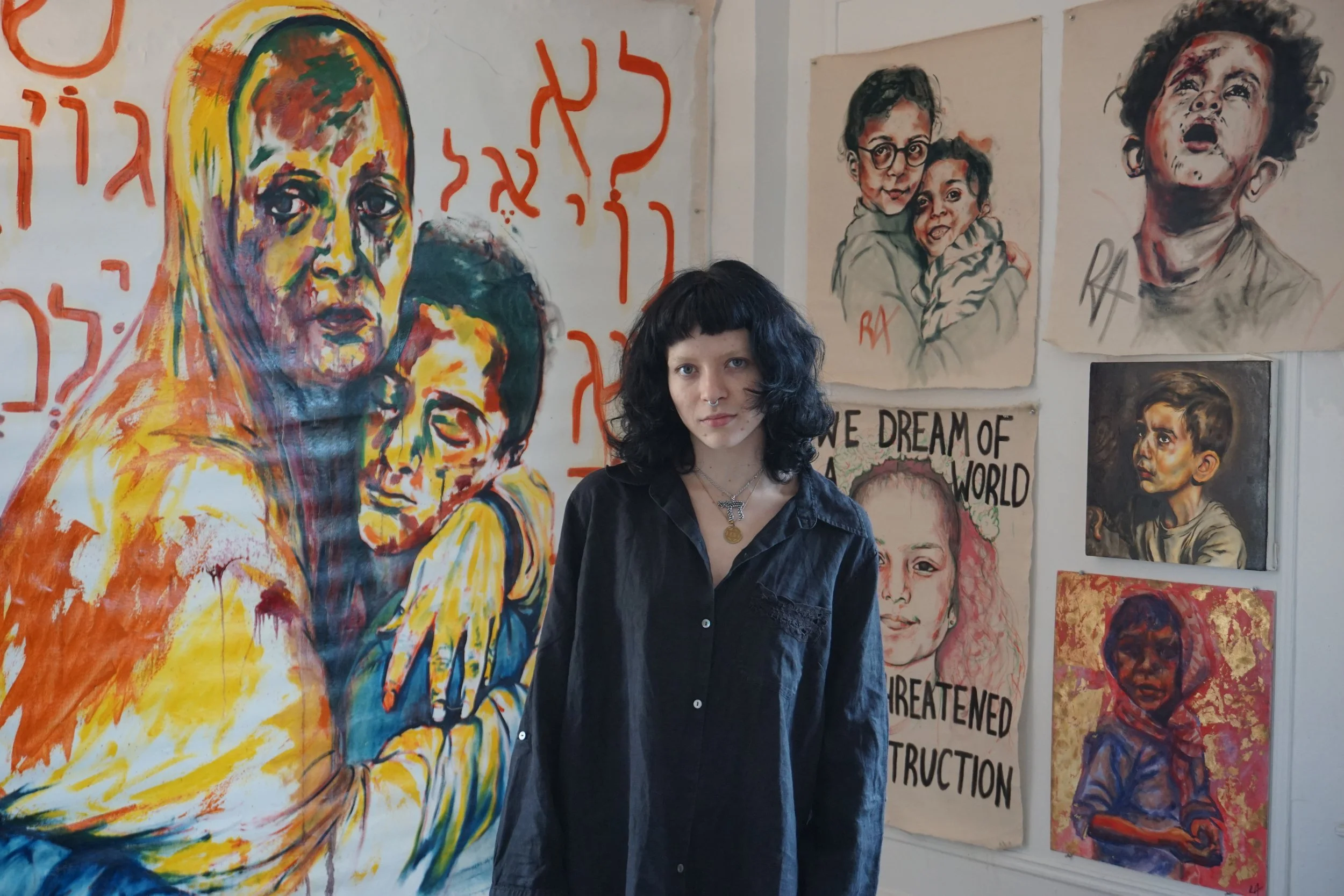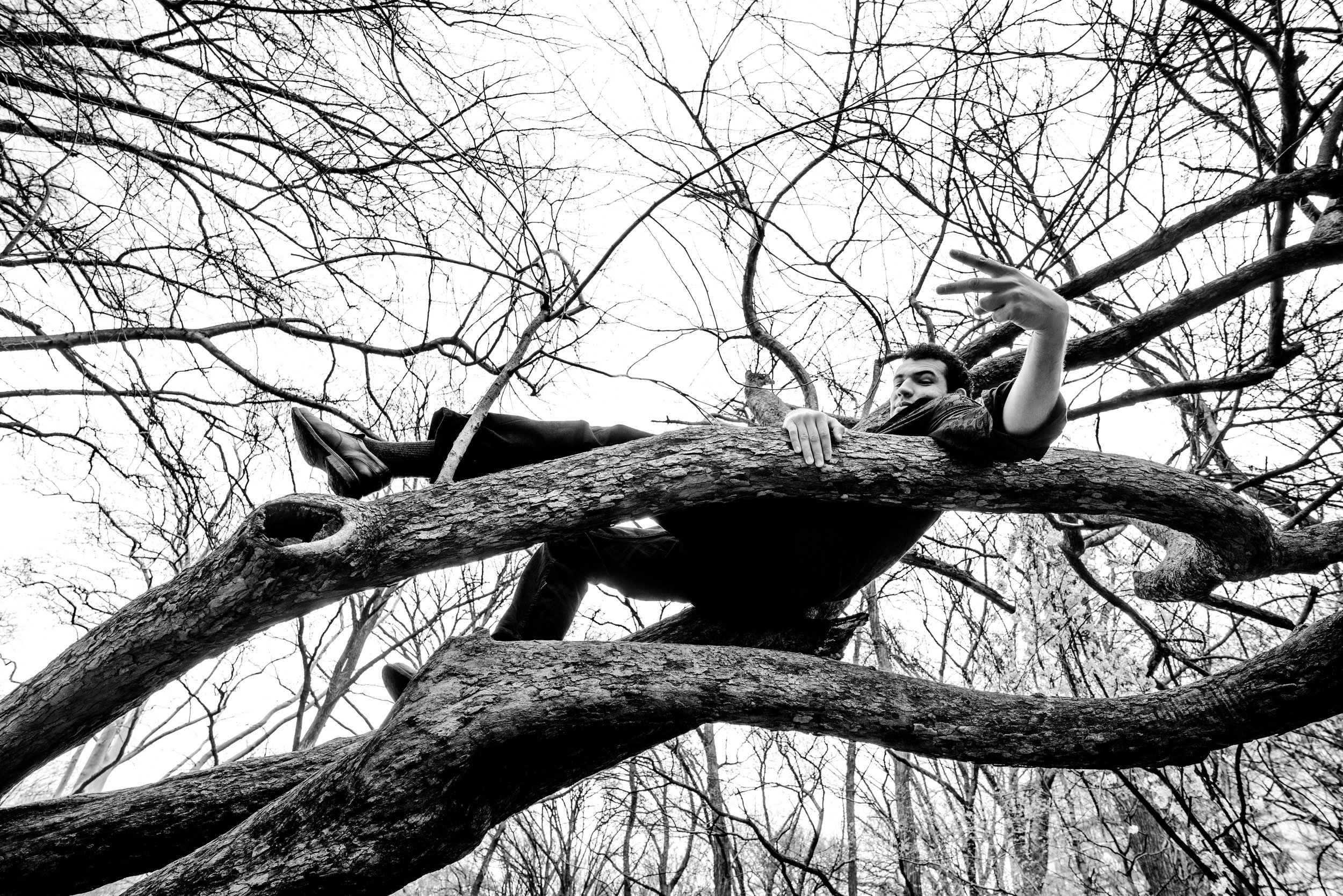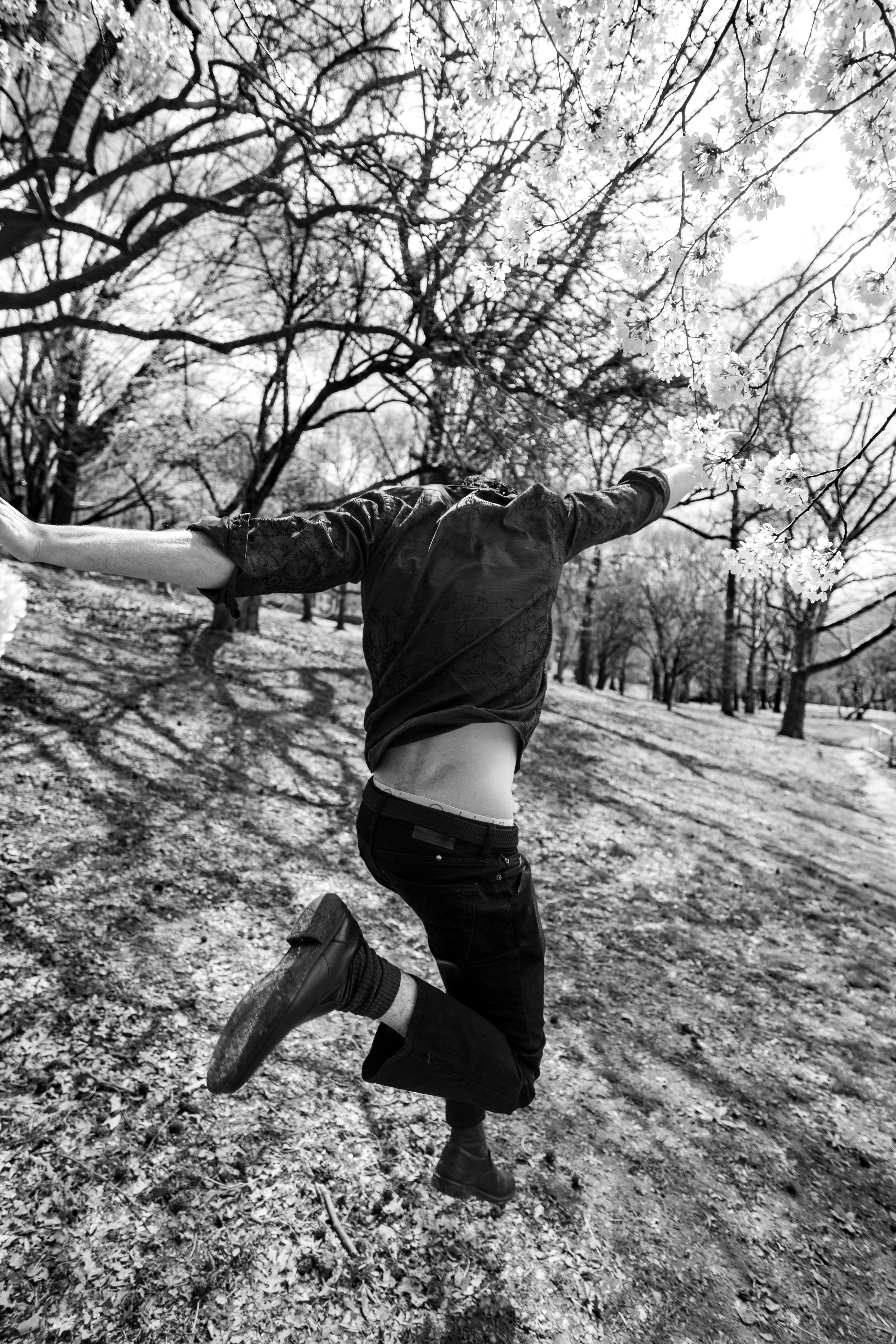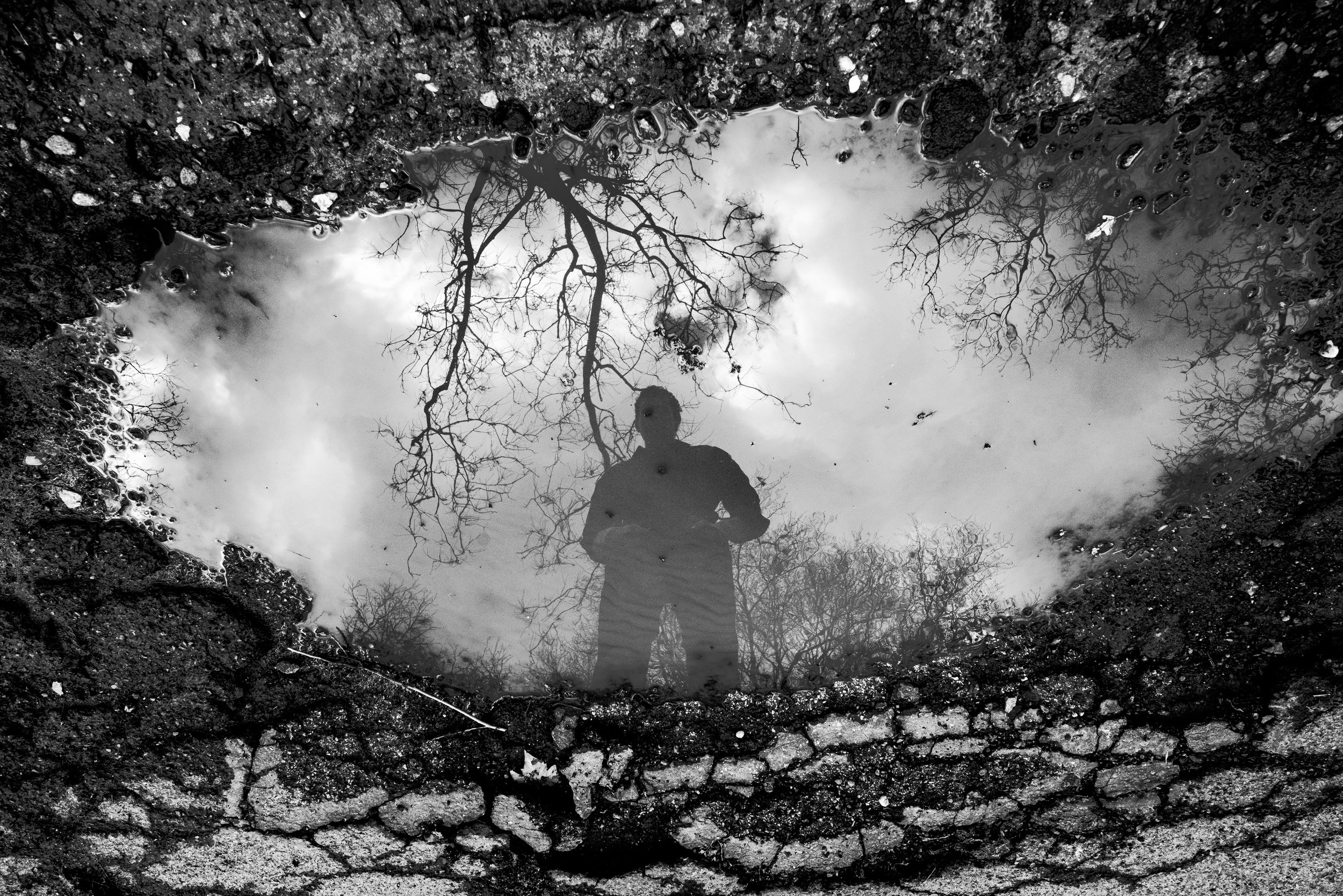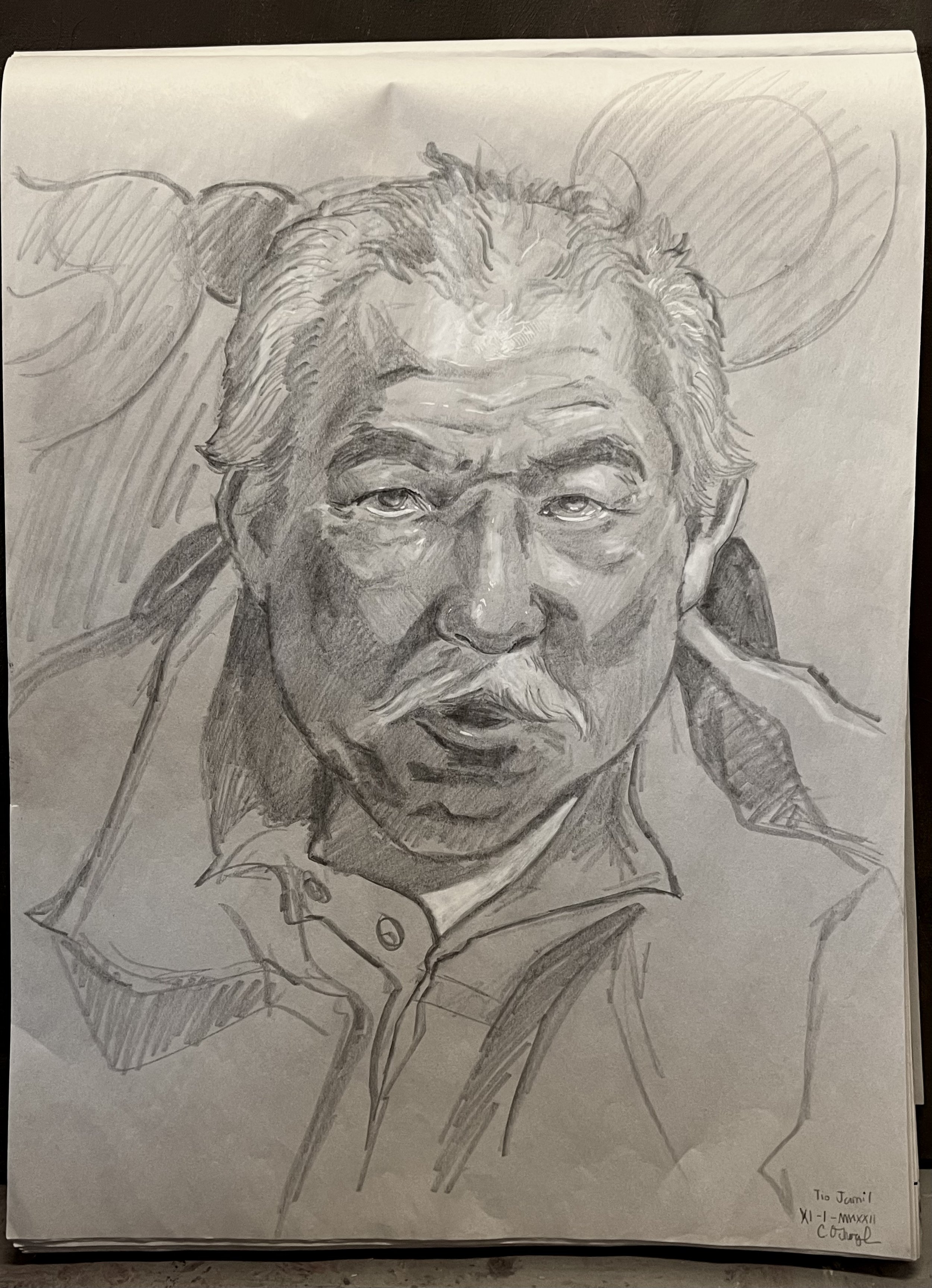Feature by Cathleen Luo
Photos by Gabi Levy
Carlos Ochoa, a senior in Columbia College studying Architecture and Visual Arts, talks about the inspirations for his Goya-esque oil paintings that comment on modern issues of gender and social media. Using thick strokes of earth-tone paint, Carlos captures themes of consumption, alienation, and masculinity on his canvases.
Carlos paints his self-portrait with furrowed eyebrows, rendering himself in moody browns and golden ochres of the classical Zorn palette. If it’s not a painting of him, then it’s other figures and characters whose anatomies twist in a moment of drama. His paintings are intense, brooding, even nightmarish at times, yet when I met with him to chat at Uris Library, Carlos was thoughtful and vulnerable about his inspirations, digging deep into the darker parts of himself to understand universal issues with body and image.
Vaquero
When I first encountered Carlos’ work on Instagram, I immediately thought of Francisco Goya’s feverish portrayals of humanity’s underbelly. Carlos is flattered by my comparison and goes on to describe how Goya’s art is “reflective horror,” something that can be seen in his own work.
Inspired by Baldomero Romero Ressendi’s work, Carlos explains: “in very few brush strokes, Ressendi is able to completely capture the psychology of a person.” Lucien Freud is another artist that influences Carlos, though in different ways; while Ressendi paints quickly and messily, Freud puts in painstakingly large amounts of time to psychoanalyze his subjects in his paintings.
Carlos’ process adopts this subjective approach in both his painting and digital work. Though he believes that his digital and traditional art practices hardly overlap, his approach to painting traditionally and designing characters are the same. He says: “I don't think people are that creative, we're just good at observing, and then synthesizing those observations.” Though he’s inspired by movies and video games for his digital art, the personalities he creates are derived from real people. He pulls inspiration directly from his everyday encounters: “If I meet someone that I'm interested in, I'll draw them. I'll try to think from their perspective; what does this person do? How would they react to certain situations?” He never knows exactly why he is drawn to a subject, but he runs with his interest to create an entire persona out of his observations.
Because he doesn’t always have access to live models, Carlos frequently turns to self-portraiture. Unlike many other student artists, he actually enjoys classic figure painting and drawing, and his skill in accurately rendering bodies is apparent. For his self-portraits, he looks at himself to see the ways the light hits different parts of his arm, chest, or back. He laughs and admits his process might seem a little narcissistic.
Self-Portrait
For anyone who paints themself enough, reckoning with your own image and how you are perceived comes with the deal. Carlos says that the theme of hypermasculinity often appears in his work since it’s an issue that plagues men who grew up on the Internet. At first glance, his paintings Cake People and Parasocial look like they are feeding into a gender binary that prioritizes the male-gaze, but unpacking the discomfort that arises from engaging with his paintings reveals deeper meditations on the toxicity of hypersexuality in society. He opens up about a problem that he thinks should be talked about more: the amount of pornography that is accessible to people at a young age, and how it distorts people’s perception of gender. He explains: “Even if you're not searching for it, there's so much of it out there. I've known people who’ve been trapped in the warped reality that porn feeds them.” He finds himself still working to shed the damaging ideas about masculinity andtraditional expectations of men to be macho, aggressive, and dominant promoted by meme culture. In portraying these themes of hypermasculinity in his art, he says, “the only way I could do it was with a very literal depiction…. It's not beautiful or cool. It’s not supposed to make you feel good.”
Cake People
He believes media like the movie The Wolf of Wall Street embodies this issue. The glorification of Jordan Belfort’s life full of money, sex, and drugs was meant to be a cautionary tale about excess but ended up doing the opposite. Everyone wants to be Jordan, the powerful, rich, misogynist. For Carlos, it’s the gluttony and vicious indulgence inherent in hypermasculinity that informs his art the most. He feels a need to warn viewers about its damaging and disturbing effects on people’s psyches.
Parasocial
When asked about how he depicts these themes of excess in his work, he replies cleverly: “Well, I use a lot of paint.” He explains that he’s noticed that there is a lot of consumption happening in his work, whether it’s people eating food, or sometimes, even each other. Figures look like they’re hungry: “We’re surrounded with so much stuff, and we always want more.” In this way, excess takes on many meanings, excess food, sex, and media in his other projects.
In order to portray this craving, he draws a metaphor to his own addiction to sugar, a playful yet sickening example of lust. He recounts: “When I first got to Columbia, I realized that you can take a fucking cake for yourself from John Jay, so I would just eat an entire cake for dinner. It's obviously not good for you, but I found myself wanting more.” This sort of pursuit of excess pleasure, followed by nausea and disgust, is a cycle that Carlos is intrigued by as a part of human nature. One way he alludes to his love for confectionaries in his art is by using thick strokes of paint because it “almost feels like food; it looks almost tasty. When I'm painting, sometimes it feels like I’m putting icing on a canvas instead of a cake.”
Lujuria
Carlos admits that his experience painting Lujuria (which translates to “Lust” in Spanish), Cake People and Parasocial, were not pleasant experiences, but he felt like had to say something about a problem that he was so aware of.
“I’m disturbed by how normalized [addiction to porn is]. It's almost weird to not watch it. And I'm not saying it’s bad thing; it's just the sheer amount that we have, how easy it is to access, especially for young people, and there are no repercussions or warnings. You could just indulge and indulge and indulge.”
He says those paintings were a reflection of society and his own experience. The discomfort in viewing his art is meant to warn and prompt reflection on gender and sexuality.
Excess is evident in many of his paintings, but one that breaks from this aggressive messaging is Siren. During the first week of the pandemic, he went home to his family who just moved away from his hometown in Florida. With the social isolation of the pandemic compounded with living in a completely new neighborhood, Carlos felt unbelievably lonely. The inspiration for this painting came from a sculpted figurine he made that ended up looking like a mermaid, reminding him of Disney’s The Little Mermaid: “She must have felt so lonely when she left the ocean and lost her fish friends. That's her home. I had just moved to Texas with my family and I knew nobody in Texas.” Visually, Siren is a “simple painting with just a figure with waves, a moon, sand, and a few rocks” but for him, it captures how infinite loneliness can feel.
Siren
Staying grounded in reality is a theme that runs through his work, and it’s even evident in the color palette he uses: the traditional Zorn palette. Zorn is a limited color palette of 4 colors, yellow ochre, ivory black, vermilion (which can be switched out for cadmium red), and titanium white. In other words, the effect of this color scheme makes paintings look “real” and “old” in its use of neutrals. Few artists stick so closely to this palette anymore. To Carlos, these pigments feel “earthy, grounded, and essential. When I paint with other colors, it feels like I'm not really engaging with my world.”
When he ends up adding other colors outside this palette, it is meant to make a statement about artificiality. The pure reds and blues that can be seen in The Cursed Party and Cake People add an eeriness to the natural and warm environment. For example, in The Cursed Party, the clowns are painted in bright, plasticky red and blue, giving the painting a sickly aura. In Parasocial, the pinks and bright blues are used to highlight the insincerity on social media and the red “Instagram-like” hearts are bright and gory, rather than cute.
The Cursed Party
When asked about how he developed his style using the Zorn palette and his unique quick brushstrokes, he explains that he did not always paint this way: “I used to draw extremely strictly often from photos in a very formal and rigid style, very realistic, ‘objective.’ Then I had Professor Susanna Coffey who taught me to be aware of your own perceptions of the world and paint that instead.” This advice added the dynamism to his practice that is now recognizable throughout his work.
Skeletons Still Life
Carlos is aware that his paintings stir up strong emotions in people, and he knows his art brings in judgment. In reflecting on how his art might be perceived, he says: “It's scary to think about how people can react to your art. I think, for the most part, I'm pretty normal. I’m definitely not a ‘tortured artist’ but I can see how my art comes off as edgy.”
One thing that does scare him about reactions to his art is that, though he intends pieces like Cake People, Lujuria, and Parasocial to be a disturbing warning, people might take it the wrong way. In the same way The Wolf of Wall Street failed to warn us away from Belfort’s lavish lifestyle, Carlos is scared that someone might find his paintings appealing or alluring. But at the end of the day, he’s made a piece of art that should stand on its own, and he has little control over how it’s seen.
Sewer Rats
Beyond painting, Carlos also jumps from hobby to hobby every month: this month it's welding and rock climbing. When I ask him about what he sees himself doing in the future, he says, as a Visual Arts and Architecture senior, he’s hoping to go into illustration or product design again, but he will definitely keep art on the side. “I would love to work at a movie or video game company designing characters or environments, but I would not want to make painting a full-time job.” He’s candid about his reasoning why he doesn’t want to pursue fine art as a career: “I only paint when I don't have time to paint, so basically, I always paint at the worst times possible. Like when you have an essay due tomorrow and you're like, fuck it. I want to paint. That's one of my best work happens, when there’s a rush, desperation, an outlet.”
You can check out Carlos’ work on his Instagram!

